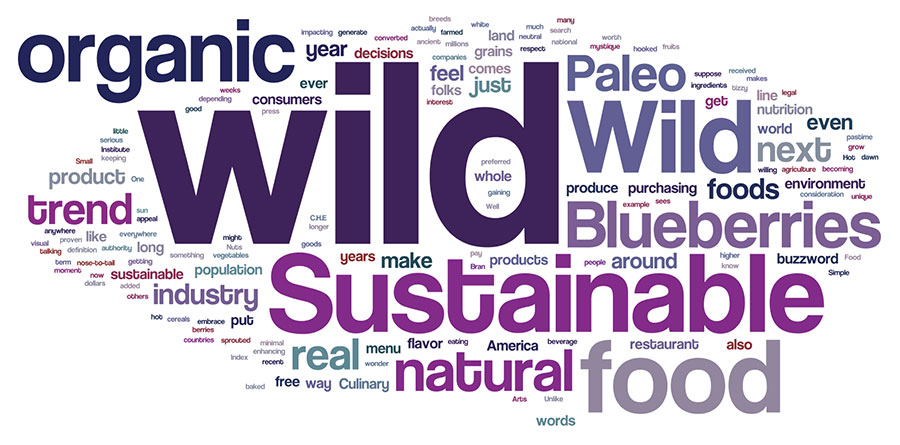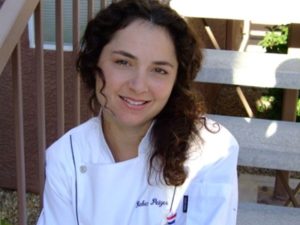Is Wild the Next Hot Food Trend?
Editorial consulting by the Culinary Institute of America
One chef’s obsession over what comes next….
Local. Artisanal. Paleo. Sustainable. Superfood. Healthy. Wild. Bacon.
Simple, yet powerful words that generate millions of dollars in the food industry each year. And, depending on which talking head, menu, or product is getting your attention at the moment, some are gaining momentum while others have already had their day in the sun.

Consumers get hooked on a buzzword for a few weeks or a few years, and it drives their purchasing decisions for everything from supermarket produce to high-end restaurant experiences. Small wonder, then, that anyone who sells something in the food and beverage world – and yes, that includes restaurant folks like you and me – obsess over what comes next.
Unlike organic, natural, or free range, many of these buzzwords have no legal definition according to the USDA or any other food regulating authority. Still, the consumer sees added value and is willing to pay a premium for it. How do you suppose marketers feel about that?
For example, whole grains converted a population of people who once preferred the neutral flavor and visual appeal of white food. At first, whole grain was simply a way to make folks feel better about traditional high-sugar cereals like Raisin Bran, but now even sprouted and ancient grains are popping up everywhere from baked goods to center-of-the-plate.
Sustainable has received its fair share of press in recent years due to the stress that our population has put on the environment just to produce food. So much so that companies have created a labeling system, called The Sustainability Index, for just how sustainable a product really is so that consumers can make more informed decisions about purchasing products they can feel good about. The desire for sustainable food products has spawned interest in other buzzworthy words such as farm-to-table, nose-to-tail, eco-friendly, and – next up – wild.
When Euell Gibbons put America in a tizzy with his famous “Have you ever eaten a pinecone?” line, little did we know that wild would ever be the next in a long line of hot buttons. Well, the Grape Nuts spokesman and author of Stalking the Wild Asparagus would be pleased that wild times are just around the corner – so get ready to embrace the term as you plan your next menu or search for ingredients to make your product even more unique.
People around the world have been eating wild foods since the dawn of time. And, in some countries, such as Denmark, foraging for your own wild foods is considered a national pastime, and the government allows it almost anywhere there is free land, as long as you respect the land.
Wild foods have a mystique about them that inherently makes them sell themselves. Wild fruits and vegetables, such as berries and mushrooms, grow with minimal intervention by humans and regenerate year after year on their own. It has also been proven that most wild foods are higher in nutrients than their farmed counterparts. Commercial agriculture breeds and farms for efficiency and cost while hoping to preserve nutrition along the way. However, consumers are becoming aware that enhancing transportability can come at the expense of flavor and nutrition while also negatively impacting the environment.
So give wild some serious consideration. It might be a buzzword that is actually worth keeping around…even longer than bacon.
About the Author

Chef Rebecca Peizer, C.H.E. C.E.C.
Associate Professor of Culinary Arts
Culinary Institute of America at Greystone
Rebecca’s passion for food set her on a path to the Culinary Institute of America where she graduated in 2000. From there, she set off to New York City where she became a private chef. She took her next big step in the culinary world when she moved to California and opened Roux, a restaurant in St. Helena in the heart of the Napa Valley. Roux quickly took off and the San Francisco Chronicle named it Top 10 Restaurants in the Bay Area 2001. On the heels of that honor, Food & Wine named her Top 10 Sous Chefsin America 2002. Over the course of her career, Rebecca has had the opportunity to work with many great chefs including Jacques Pepin, Martin Yan, Bradly Ogden, Cindy Pawlcyn, and Julia Childs. She has catered events for presidential candidates, Napa Valley winemakers, and prominent artists, and now shares her passion for food and wine with students at the Culinary Institute of America at Greystone in Napa Valley.

